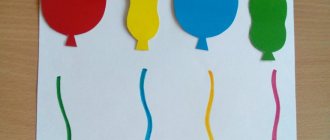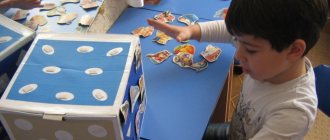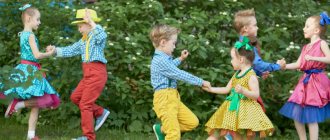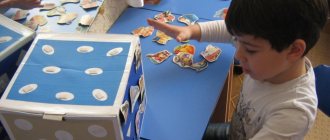Features of development of children 5-6 years old
When creating a card index of games for children 5-6 years old, you need to take into account the characteristics of this age. After all, these are no longer the same kids who are ready to spend hours selecting the right part for the sorter, assembling a pyramid or moving a gurney, enjoying these activities. Children attending the senior group of kindergarten have already accumulated a considerable amount of knowledge and skills. They:
- independent;
- speak well;
- are able to analyze the situation;
- explain some phenomena;
- defend their opinion;
- work in a team;
- can carry out tasks according to instructions.
Priorities in games are also changing. Older preschoolers prefer to play with peers rather than with parents; the time has come for role-playing entertainment. However, these are not the only favorite activities. Kids are not averse to frolicking on a walk, playing board games, doing creative work, taking part in competitions or musical entertainment.
There are many games available for 5-6 year old children. Their classification is quite arbitrary. We offer a selection of three types of games for preschool educational institutions - active, played indoors or outdoors; low mobility (with teaching aids); plot-role-playing.
Objectives of didactic games and toys
The main objectives of using educational games and educational toys in teaching young children:
Too lazy to read?
specialists and get an answer in 15 minutes!
Ask a question
- Enrich your child's sensory experience by promoting perceptual development.
- Development of logical thinking, memory, observation, ability to express one’s feelings and thoughts.
- Sensory development.
- Nurture discipline, correctness, honesty, order and strong-willed qualities of the child’s personality, observing the rules of the game.
- Formation of moral concepts and ideas, assimilation of generally accepted norms and rules.
- Education of aesthetic feelings.
Didactic games as a method of teaching young children have their own specific structure:
- Orientation: the child knows the theme of the game, its rules, general course and content.
- Preparing for the game: distribution of roles, familiarization with game actions, consideration of current procedural tasks.
- Direct play: children play independently, the teacher only observes the progress of the game and, if necessary, helps, corrects or guides.
- Discussion of the game: Analysis of the game is carried out in the form of discussion.
In educational games, in addition to didactic material, educational toys are often used. Various cones, turrets, pyramids, spheres, mosaics, etc. are used as educational toys.
Sedentary didactic games in the senior group
Older preschoolers are still characterized by insufficient stability of attention, a predominance of involuntary memory, visual-figurative thinking, and unformed cognitive motivation. Don’t forget that these children are tomorrow’s schoolchildren, and for successful learning you need not only to teach your child numbers, letters, or prepare his hand for writing, but also to take care of the development of cognitive functions. Didactic games allow you to overcome all these difficulties. They are aimed at:
- creating and maintaining interest in a subject or process;
- development of mental mechanisms (memory, imagination, observation, perception, intelligence, attentiveness, speed of thinking, speech, feelings and emotions);
- formation of desire to achieve a goal (goal setting);
- increased self-esteem;
- social affirmation.
To organize an exciting process, you will need educational toys. Such as:
- Designers. If at 3-4 years old children, playing with a construction set, train fine motor skills, then at 5-6 years old, the main task is to achieve the set goal. This can be the construction of a structure according to the scheme proposed by the teacher or according to an independently invented project. The main thing is to get the desired result.
- Puzzles. Collecting pictures from disparate elements is one of the most favorite activities of kids. At 5-6 years old, children can easily cope with sets of 40-50 fragments. You can collect pictures one by one or arrange a competition by dividing the group into several teams. Whoever draws the picture the fastest is the winner.
- Tangram. The puzzle, originally from China, allows you to create thousands of different silhouettes from 7 geometric shapes. You can organize exciting activities with it, inviting children to imagine and collect as many images as possible in a limited time.
- Lace beads. You can string objects on a cord in a certain order: by the color of the elements, their shape or content. For older children, lacing will not only be an exciting game, but will also help them prepare for school. Whoever can correctly arrange the numbers in ascending/descending order, form the syllables, and make the most beautiful necklace by stringing beads in the order dictated by the teacher - well done!
- Domino. This is a well-deserved leader among printed board games for kindergarten. You can purchase children's themed sets, where instead of dots on the chips there are drawings: transport, fruits, vegetables, animals, flowers. Such manuals allow preschoolers not only to acquire communication skills and learn to think logically, but also become a simulator for cognitive development. In the older group, children can be offered the classic version of the game, “Closers”, “Cross”, or come up with their own rules, taking into account the age and inclinations of the tournament participants.
- Memory. It’s hard to find a better activity for training memory and attention than this “board game.” The goal of the game is to quickly find pairs for your chips among the closed ones located on the common field. Each participant opens one card for a second, and the others remember what is shown there, and in the future they can use this knowledge for their own purposes.
- Clothespins (counting material). Having prepared plates with numbers and signs “+”, “-”, “=”, the teacher distributes them to the children and offers to attach the appropriate number of clothespins to each number plate. The goal of the game is to become familiar with counting and simple mathematical calculations.
- Musical instruments. To organize musical and didactic classes aimed at developing hearing, you will need as many children's instruments as possible: xylophone, metallophone, drum, tambourine, maracas. Hide them behind the curtain and ask the children to guess in what order they sounded. To add an element of competition to the game, you can divide the group into several teams. Whoever correctly determines the order of sound of the instruments wins.
Sedentary games can be organized not only with the help of toys. Pictures with different images are suitable for this. They are usually used for speech development classes. Eg:
- "Who's for a treat?" Each child is given cards with animals depicted on them (hare, fox, elephant, monkey, etc.). The teacher says that he has a basket of food, but he does not know which animal to offer what, and names one of the treats, for example, a banana. Children must choose a picture of a monkey from the set and pick it up.
- "Zoo". Children sit in a circle, and the teacher gives each one a picture of a bird or animal, which the children do not show to each other. A top with an arrow is placed in the center of the circle; whoever it points to must create a verbal image of their animal or bird without naming it. For example, where he lives, what he eats, what color he is. The top is launched again - this time it will point to the one who will answer.
- “Name the details.” The teacher shows pictures of transport, buildings, plants, berries, and the children must name their parts. Whoever can remember the most details wins.
Remember that children 5-6 years old can engage in sedentary games for no more than 20-30 minutes without a break. This is how long they can concentrate their attention. Therefore, classes must be alternated, moving from calm to active fun.
Didactic games for the younger group of kindergarten
At the age of 2-3, children actively get acquainted with the world around them and learn basic concepts. Didactic games for this age group are simple and involve one action. Group games are recommended; they teach kids to follow collective rules, develop communication and interaction skills to achieve goals.
Find a couple
For the game, prepare pictures of mittens and hats in 4 colors: green, red, yellow, blue.
Tell the children that the dolls are going for a walk. They have already put on their hats, but they can’t find mittens of the same color, they need help. Arrange the pictures chaotically on the table. The players' task is to find mittens that match the color of each hat.
Several people can play, each selecting their own 4 pairs. In this case, you can organize a competitive game: the first one to match all 4 pairs of mittens to the hats wins.
listen carefully
Give each student a flag. Play music or, if you are musically inclined, play an instrument. When the music is low, children should sit quietly with the flag down. And when the music starts playing loudly, the students raise a flag above their heads and wave it.
Make beads
For the game, prepare laces and beads of 4 colors: red, blue, green, yellow.
Tell the students that the dolls have gathered for the name day, but they have nothing to decorate themselves with. Offer to make beads, show the children laces and a box of colorful beads. The task is to select beads of a certain color from a box and attach them to a cord of a similar color.
The game can be competitive. 4 children play, each making beads of a given color. The one who finishes it faster than the rest becomes the winner.
Find your match
To play, make cardboard geometric shapes in different colors. Distribute the pieces in pairs according to the number of players.
Place the cards in a box and ask the children to take them out one at a time. Let the players look at the pieces, then find the same one from a friend. You can repeat the action many times. You can complicate it by dividing geometric shapes not only by color, but also by size.
Collect a picture
Prepare pictures for the game depicting objects familiar to preschoolers, cut them into 4 parts. Also place real objects in front of the children that match the pictures.
The players' task is to collect the picture. The player who completes the task correlates the resulting image with a real object. The winner is the one who first collects the picture and correctly points to the object corresponding to it.
Bad or good deed
Print out pictures with positive and negative stories for the game. Let the students look at the images and evaluate the actions of the characters. For example: “The boy pulled the girl’s pigtail. The girl began to cry. He did something bad."
Butterflies are flying
To play, cut out 5 butterflies from colored paper. Tie each one with a 50 cm thread. And secure the thread to a rope stretched horizontally. The distance between the figures should be approximately 40 cm, and their height should correspond to the eye level of the preschooler.
Tell them that butterflies fly beautifully. Blow on one of them, ask the students to do the same. Children take turns standing near the paper figures and blowing on them. The game is competitive, the one whose butterfly flies farthest wins. Make sure that players keep their back straight, do not tense their shoulders when exhaling, and do not puff out their cheeks. Each player exhales once, and it should last no more than 10 seconds, otherwise dizziness may begin.
Outdoor games in the senior group
If the weather permits, active activities are best done outdoors. After all, then, in addition to training coordination, agility, accuracy, endurance, a powerful saturation of the body’s cells (including the brain) with oxygen is added. And this has a positive effect on the efficiency of mental activity.
There are a lot of options for outdoor games for preschoolers. These are team competitions, fun games that teach certain skills: jumping rope, hitting a target with a ball, lining up in a line and running in all directions. In the older group, as a rule, the emphasis is on games that foster team spirit, perseverance, and the will to win. The most interesting of them included:
- "Ball relay" Four ropes, 3-4 meters long, are pulled, forming paths 70 cm wide. Children are divided into two teams. The goal of each player is to carry the ball without going beyond the designated boundaries to a landmark, and, upon returning, pass it to the next participant. The team that finishes the game first wins.
- "Marathon". Draw two lines at a distance of 50 m. Children run at an average pace from one to the other, and then return. Everyone has the opportunity to retire from the marathon at any time or run until they run out of energy. The most persistent one wins, the one who remains on the field last.
- "Pass the ball." Two teams compete. The participants of each line up, at arm's length from each other. At the teacher’s command, everyone sits down, and the first of them is given a ball. He passes the ball over his head to the seated participant behind him, and he stands up, turning to face the team. This is what all other players do. Whoever drops the ball must catch it and, returning to his place, continue the game. The team whose members are the first to stand on their feet wins.
- "Homeless Hare." Hoops are laid out on the site or circles are drawn - these are houses for hares. The teacher assigns a wolf and a homeless hare. All the animals are sitting in their holes, and the homeless man is running from the wolf. He can only escape by running into someone’s house, but then the owner must jump out of it and run away from the predatory beast. If the wolf managed to catch the hare, they change roles.
- "Mousetrap". Children are divided into two unequal groups. The smaller one is a mousetrap. They stand in a circle and join hands, raising them up, representing the open doors of a trap. The second group is mice walking around the site. They run into the mousetrap and leave it unhindered until the signal sounds: “Pop!” The trap slammed shut, and whoever did not manage to leave it becomes a “link” of the mousetrap. When most of the mice are caught, the teacher changes the children's roles.
Little children are restless fidgets, ready to frolic all day long. This is far from a meaningless pastime, but a very necessary process, especially for hyperactive kids. Active activities help the child to release accumulated energy, excessive tension, aggression and, with renewed vigor, begin the next fun, for example, role-playing games.
The importance of didactic games and toys in the education of young children
Educational games and educational toys are of great importance in the learning, learning and development of young children. After all, it is a game and a toy that can simultaneously teach, educate and bring joy to a child.
From an early age, a child actively learns about the world around him, through studying what is happening around him. In this knowledge, he is actively helped by educational games and toys, which help expand the child’s horizons, teach him to observe and highlight the characteristic features of objects, and establish simple relationships between them.
Too lazy to read?
specialists and get an answer in 15 minutes!
Ask a question
Educational games and toys are of particular importance in the education of young children, since with their help children learn and assimilate the norms and rules of behavior in society and acquire skills of interaction with others. All these skills are necessary for children not only for successful subsequent studies at school, but also for successful socialization in society.
Observation 1
A didactic game and a toy are inseparable from each other. Thus, an educational toy can become the beginning of a game during which a storyline unfolds that requires additional toys.
The value of educational games and toys is that they introduce children to life, promote their mental development and provide opportunities for all types of children's activities.
Role-playing games in the senior group
At 5 years old, a child becomes aware of his gender identity. Boys begin to imitate their dads, superheroes from their favorite cartoons, and girls begin to pretend to be fairies and little princesses. This means that the time has come for role-playing games. This is a very important moment in raising a child, because these fun things are not as simple as they might seem at first glance. They are helping:
- learn the rules and norms of behavior;
- accelerate speech development;
- learn to evaluate your own and others’ actions;
- perceive yourself as part of society;
- develop emotions, imagination, intellect;
- strengthen communication skills.
Story games can be divided into several groups: social, everyday, staged and patriotic. Any of these types of entertainment are important for the harmonious development of personality.
Social
Social role-playing games will help you find out what adults do at work, about various professions, rules of behavior in public places, and also undergo rapid socialization. In the senior group of preschool educational institutions, children will be interested in:
- School. How to behave in class, why you shouldn’t be afraid of the teacher, how knowledge is assessed and what recess is - children will learn about this and much more from playing school. The teacher, as a rule, takes on the role of a teacher, and the pupils take on the role of students. In a playful way, children are explained the rules of behavior in this institution and the basic principles of education.
- Clinic. The teacher selects doctors: an ophthalmologist, a dentist, a surgeon and their assistants - nurses. Children bring “sick” toys to the appointment. Before you get in line, you need to understand which specialist you need to contact. The doctor examines patients, prescribes treatment, and the nurse gives injections, helps “cut out the appendix,” and measures temperature and blood pressure.
- Bank. They choose a manager, an operator, a security guard. Children can take out a loan, withdraw cash from a bank card, open a deposit, and at the same time understand what the employees of this establishment do. The game can be made more exciting if robbers suddenly descend on the bank.
In addition, children will enjoy playing at the police, the Ministry of Emergency Situations, a store, a beauty salon or a cafe.
Household
The game of “family” is a classic of the genre. Girls are happy to play the role of mother and grandmother, and boys, accordingly, are not averse to trying themselves as the head of the family. The teacher can suggest any topic: “Celebrating the New Year,” “Grandmother’s Birthday,” “A trip to pick mushrooms or go on vacation,” etc. The adult’s task is to outline the plot and assign roles; the children will do the rest themselves. After all, they often become participants in the same events, only real ones.
A very interesting game “Courtesy Shop”. Here, instead of goods, they sell polite words. The teacher prepares the cards in advance. He tells the pupils about situations that often arise in the family, between close people, and offers to find a way out with the help of “magic” words. For example, a child broke a vase and hid his crime from his mother. The teacher offers to visit the store and choose from all the words available there the necessary words with which you can apologize and ask for forgiveness.
Staged
Choose your favorite fairy tale with your children and prepare a theatrical performance. The teacher’s task is to select the necessary items for the production, introduce the children to the work and voice the responsibilities of each character. As a rule, staged games begin with “Turnip”, “Teremok” and “Kolobok”.
Patriotic
Patriotic games teach endurance, obedience to certain rules, and cultivate strong-willed qualities. For pupils of senior preschool age the following are suitable:
- "Scouts". The teacher prepares props in advance (package with tasks, obstacle structures, medals). After this, he distributes the roles: scouts, snipers, commander, nurse, and talks about the exploits of the soldiers during the war. Among the tasks are a small quest to find a map, crossing a “stormy river” on a narrow bridge (benches), hitting a target with sandbags, for a nurse – bandaging a “wounded” person, putting a splint on a broken arm. The task was completed successfully. A march plays, and the scouts line up and receive medals from the hands of the commander-in-chief.
- "Outpost". The teacher explains what a border is and how important it is to protect it. Explains where border guards live and how their days pass in peacetime. Among the participants: the outpost commander, border guards, dog breeders, a nurse, a cook and enemy spies. According to legend, the border has been violated. An alarm has been declared at the outpost. The squad is sent in search of violators. Not everyone will survive, but there is a medical unit at the outpost where the wounded will be treated. The cook will not be left without work - he will prepare a delicious lunch and treat the tired soldiers.
Games are needed to prepare a child for the future and to make the present interesting and happy. These tasks will be accomplished if children's fun is taken seriously, a thoughtful approach is taken to the choice and all conditions are created for their implementation.
Didactic games for the middle group of kindergarten
For preschoolers aged 3-4 years, didactic games are a way to expand their individual vocabulary and familiarize themselves with the objects of the surrounding world. Children learn the parameters and characteristics of objects, learn classification and comparison, and consolidate previously acquired knowledge.
When does this happen
For the game, prepare pictures with scenes from the daily life of a preschooler and place them in front of the students. When you say “morning,” children should look for images that correspond to that time of day, for example, brushing their teeth, doing exercises, combing their hair. Players who pick up the correct picture receive a point. The player with the most points wins.
Does this happen?
Say phrases relating to objects and phenomena of the seasons, and the students must say whether this happens. For example: “On a hot summer day, we left the house with a sled to go down the hill.” Or: “In the spring, birds began to gather in flocks to fly to the southern regions.”
What can you do in this place
Ask a question about a certain place, and the children must say what can be done there. For example: “On the river you can... swim, sunbathe, build sand castles, fish, ride a boat.” Or: “In the garden you can... weed the beds, water the plants, harvest the crops, set up a scarecrow.”
Name the signs
Say the words, and the children should take turns naming their signs. For example: a fox is red, cunning, beautiful, dexterous, tailed, fluffy. Or: the house is tall, brick, wooden, new, destroyed, spacious.
What does it sound like
For the game, prepare several boxes with different contents: sand, turf, grain, beans, pebbles. Demonstrate to the students what different substances sound like: shake each box. Then mix them up and, without showing the contents to the children, shake them again. Players must guess by the sound what substance is inside.
Shop
Organize an impromptu store, lay out various toys on the counter. Explain to children that they can buy a toy when they do not name it, but describe its features. Moreover, when describing, you cannot look at the item, so as not to give the seller a guess. The seller must, based on the signs presented, guess what kind of toy we are talking about and give it to the buyer. For example, a buyer says: “I need a round, bouncy, rubber toy.” The seller selects a ball.
Hide and seek
Organize a game on the kindergarten playground if there are a lot of trees and shrubs of different types. Or take your students to a city park.
Children choose who will search and hide behind trees and bushes. Your task is to guide the seeker, suggest where to look, without naming the type of plant. For example: “Find the one who hid behind a tall tree with a hollow and carved leaves.”
Name the action
Ask questions, and students must answer with verbs. The player who answers correctly receives a point. The one who collects the most points wins. For example: “What does the teacher do? - teaches a lesson, checks notebooks, educates, grades, writes on the board.” Or: “What can you do in the kitchen? “cook soup, peel potatoes, make tea, have lunch, wash dishes, bake pies.”










